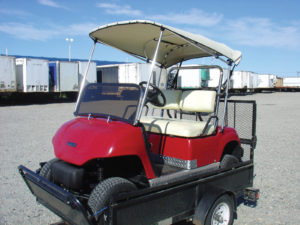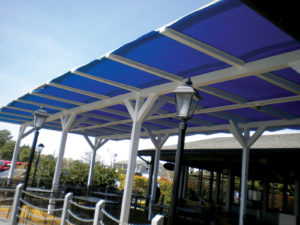Off the beaten path
Uncommon, unique and outright strange requests are a regular for marine fabricators. Here are some favorites.
Chris Griffin never thought she’d find herself in the restaurant business when she started B & C Custom Canvas of Hampton, Va., with her partner, Buck Tucker, nearly 10 years ago. But that’s exactly where she has found herself for nearly half of the past year.
“One of the boaters we’ve done work for mentioned us to the owner of a local restaurant called the Water Street Grille on the York River in Virginia,” she recalled. “They called and asked if we did outdoor enclosures and upholstery for outdoor eating areas.”
Not one to balk at a strange request, Griffin went to the restaurant to check things out. “Wintertime is generally a downtime for canvas people,” she says. “But once we took on the Water Street Grille project, all of the sudden we started getting restaurant after restaurant after restaurant. It kept us busy all winter.”
In a matter of a few weeks, three more restaurants had contacted Griffin, and more called her in the months to come. “We’ve done cushions for the outdoor seating area of the oyster bar, enclosures for Harpoon Larry’s [another nearby restaurant], along with seat cushions and bar stools for several other restaurants,” Griffin says. “Some of these restaurants now have outside areas that hold an extra 80 or more people. They love it because they can put some gas heaters out there in the winter and people can eat right by the water. All of the work was accomplished in our off season, and we used Stamoid, WeatherMax and Regalite materials that we already use for marine applications.”
The Customer Is Always Right

Among the odd requests William Bennett of Boat Bright Custom Canvas in Hardeeville, S.C., has received was for a virtually “flat” bimini. It proved to be an exercise in both geometry and engineering.
Unusual requests don’t always open the door to new markets, however. William Bennett of Boat Bright Custom Canvas in Hardeeville, S.C., learned this the hard way when he took on one of the most unusual requests he ever encountered.
“We had a customer ask us to build a set of tow-rope covers for his sailboat to cover the varnish on the boat,” Bennett says. “That in itself was not a big deal. However, he wanted it to be one continuous piece from the port side across the stern and back up the entire starboard side. He didn’t want us to use any fasteners on the boat, and the covers had to include two sets of bungees that went the complete 90-foot length of the vessel, one on the top and one on the bottom.”
Bennett knew the unusual project would be a challenge to make, install, and for the customer to use.
“I tried to talk him out of it,” Bennett says, “but in the end he wanted it done. We sewed it, installed it, and got paid.
“Putting it on for the first time wasn’t a challenge, as I sewed the bungees in slack. When I pulled it tight to load it, I cut the excess bungee off. It wasn’t until I installed it that I shortened the bungee and knotted the ends. Dealing with that tension after it was installed was going to be a major challenge. In fact, we never saw it on the boat again after we installed it.”
Bennett still thinks of the project fondly, however. “It was one of the coolest things we ever did, because it was 90 feet of tow rope without any fasteners, which is an accomplishment in itself. It was a very strange idea, but the customer insisted on having it.”
Bennett has had better luck with other unusual requests, including a custom bimini he installed for one of his regular customers, and a one-of-a-kind boat cover.
“A customer wanted a bimini for the front of his boat, which wasn’t unusual,” Bennett says, “but he wanted it to lay almost perfectly flat instead of the bows standing upright. He wanted his wife to be able to lay down on the bow, but he still needed to be able to see over the top. It also had to be collapsible, and have all the features of a regular bimini, just not the height of it.”
The custom bimini design required some geometry homework, but in the end Bennett got it right. “We put supports on the four corners, almost like a stanchion,” he says. “We put them almost right on the shoulders so the weight wouldn’t collapse on itself. The bows are a 30-degree angle on one side and a 10-degree angle on the other.”
In the end, Bennett’s customer loved the custom bimini. “We accomplished exactly what they wanted,” Bennett says.
The unique boat cover Bennett and his crew took on came at the request of an older gentleman who wanted to cover his boat but didn’t want to handle any poles.

Devlin McKee of Fairbanks, Alaska-based Custom Canvas builds boat-style tops with some modifications for four wheelers called side-by-sides and golf carts. “The customer is happy and so are we,” he said.
“Normally, with a boat cover, we design and sew it so it attaches around the boat and has enough slack for a pole or set of poles to elevate it in the middle so water can run off,” he says. “This customer didn’t want to deal with the poles, and instead wanted a cover that would collect water in the middle and then channel it off of the boat instead of shedding it like a traditional cover. We let the cover sag down in the middle and the water gathered and flowed off of it like a river. It was angled just enough so the water would run out the splash well and drain out the scuppers.”
“With projects like these,” Bennett says, “I tell people, ‘I’m just your guide. Ultimately it’s your boat, and if you know the risks, I’ll do it.’”
Devlin McKee of Fairbanks, Alaska-based Custom Canvas has also seen his fair share of uncommon projects.
“We do a lot of custom stuff up here,” McKee says. “Over the last few years I’ve built some really unique frames in some tight spaces. Things like custom canopies for fishermen, and camper extensions for recreational vehicles.”
Some of the most unique projects McKee has handled involve large four-wheeler type vehicles called side-by-sides.
“We mainly do boats, but a lot of the guys up here have side-by-side vehicles that don’t come with doors or tops,” McKee explains. “We’ll do a boat-style top with some modifications for a side-by-side or a golf cart. The customer is happy and so are we.”
Animal kingdom
Katie Bradford, owner of Custom Marine Canvas in Noank, Conn., may have some of the most unusual projects of all.
“One of our boat customers, one we’ve done a lot of interior and exterior work for, came into town one day after being newly married. His wife had cats that she wanted leashes and harnesses for. She had bought ferret harnesses, but they were too small,” Bradford recalls. “We were on the boat looking at cushion and carpet work that needed to be done, and out of the blue, she said ‘Oh, by the way, could you help me with this?’”
Bradford said yes, possibly making her the first marine fabricator to dip into the cat harness market. Her animal harness escapades didn’t stop there, however.

Covering outdoor dining areas at marina-side restaurants has turned into a new business arena for Chris Griffin of B & C Custom Canvas of Hampton, Va. In fact, while her marine business first attracted the attention of restaurant owners, that work has gotten the attention of other boaters. The two businesses keep her busy year-round.
“We also did a harness for a sea lion at the local aquarium in Mystic, Conn.,” she says. “It was made so the sea lion could carry a camera out into the wild and film its natural habitat.” Bradford had to physically measure the sea lion, entering its living area at the aquarium. “I had to coat my shoes in a special disinfectant so as not to contaminate the animals. The trainer held the sea lion steady, and I had to actually raise the flippers and get the tape measure around its chest,” she says. “Once I got the right measurements, I used one-inch tubular webbing and Fastex buckles to make the harness.”
Much like the off-season restaurant projects became a new market for Griffin, Bradford has found that non-marine markets have also opened up for her when she has taken on uncommon projects.
“We’ve done experiment containment systems for scientific labs using Mylar film, and Stamoid fabric tubing for circulating air in energy plants,” she says. “When an unusual job needs to be done, people think about who would have a heavy-duty sewing machine, and often times they turn to us in the marine canvas business.”
Griffin agrees, and has seen her restaurant work come full circle to more marine work. “Restaurants have become a great way to finance our marine off season, and most of the restaurants are on the water with marinas,” she says. “We have already received calls for several boats since installing the enclosures and upholstery at local waterfront restaurants.”
Jake Kulju is a freelance writer from Minneapolis, Minn.
 TEXTILES.ORG
TEXTILES.ORG 


